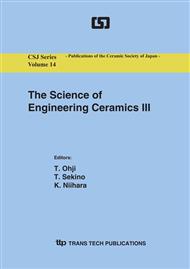p.297
p.301
p.305
p.309
p.313
p.317
p.323
p.327
p.331
Gas Pressure Dependence of Photon Emission Accompanying Fracture of Polycrystalline MgO in Nitrogen
Abstract:
The photon emission accompanying fracture of a polycrystalline MgO was investigated at room temperature under N2 gas pressures from 10-4 to 105 Pa. At fracture, the ultraviolet, visible and infrared photon emissions instantaneously increased, and then rapidly decreased in most of the experimental conditions. However, in a N2 gas pressure of around 100 Pa, their peak counts lasted for about 10 milliseconds, and the amount of the UV photon emission was fifteen times larger than those obtained in the other N2 gas pressures. This abrupt increment in the emission was explained by the luminescence due to N2 gas discharge according to the classical Townsend’s theory. In conclusion, the photon emission accompanying fracture of a polycrystalline MgO mainly originated from the excited defects as reported by the authors previously, but the N2 gas discharge had a supplementary effect on the emission around a specific N2 gas pressure.
Info:
Periodical:
Pages:
313-316
Citation:
Online since:
August 2006
Authors:
Price:
Сopyright:
© 2006 Trans Tech Publications Ltd. All Rights Reserved
Share:
Citation:


